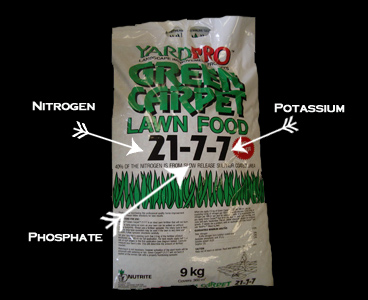
Step One
Lime – The best time to lime your lawn is in the spring. It helps neutralize acidic soil. Lime will sweeten up your soil and help keep your lawn in good shape.
(Lime is a treatment for your soil, not your grass).
Step two
Moss control – Apply moss control in the morning or evening as grass needs to be moist.
Step Three
Top dress – Apply top dress soil mix to fill holes and smooth the lawn area.
Apply ‘Over seeding’ grass seed to bare areas of your lawn.
For soggy lawns or clay soils aerating is recommended followed by applying a thin layer of washed sand ¼ inch thick.
Step Four
Fertilize – Good (12-4-8) Better (slow release fertilizer) Re-apply in mid summer.
*See below what the numbers mean on a fertilizer bag

Grass needs three main nutrients:
- Nitrogen (N) – will give your lawn its rich, green color.
- Phosphorous (P) – a primary nutrient that encourages rooting, blooming and fruit production.
- Potassium (K) – helps plants resist disease and aids in winter hardiness.
Important information on Grubs/Chafer Beetles
What they are:
Grubs are the larvae of various beetles that feed on the roots of turf.
What they do:
By chewing on the roots of your lawn, it causes the grass to wilt and turn brown. In addition to the damage the grubs themselves will cause, other animals such as birds, raccoons and skunks will start ripping up your lawn to get at the grubs.
What you can do to prevent/remove them:
– Keep your lawn healthy! Regularly water, fertilize and mulch. Don’t mow it too short.
– Aerate! Beetles are fond of compacted soil for laying their eggs. Disturbed soil is less likely to attract them.
– Use Nematodes. Typically use in late April to mid June, and again in early August through October. Each pack covers approximately 3000 square feet.
– Use a mixture of Diatomaceous Earth mixed with a soap powder at a rate of 6-9kg per 100 square meters.
– Use Scotts Grub B Gone – Typically apply in April to late May, late June to early August or late August to September. Apply 1.12kg to 1.68kg per 100 square metres.
– Use a grub/beetle resistant grass seed, something that includes Micro Clover and Tall Fescue. This can not be used as an overseeding. You have to start from scratch in order for this method to be successful.
Try to stay away from harmful chemicals. It has harmful impacts on your lawn and the beneficial bugs that call your yard home.

